
Chives, scientific name Allium schoenoprasum, is a species of flowering plant in the family Amaryllidaceae that produces edible leaves and flowers. Their close relatives include the common onions, garlic, shallot, leek, scallion, and Chinese onion.
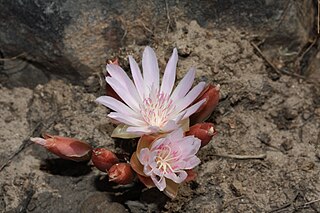
Bitterroot is a small perennial herb in the family Montiaceae. Its specific epithet rediviva refers to its ability to regenerate from dry and seemingly dead roots.
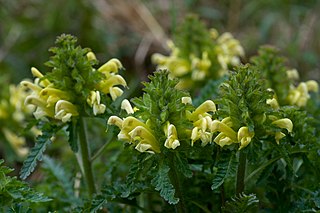
Pedicularis canadensis, commonly called Canadian lousewort or wood betony, is a flowering plant in the family Orobanchaceae. It is native to North America, where it is found in southeastern Canada, the eastern United States, and eastern Mexico. It has a wide-ranging natural habitat, being found in mesic to dry, forests, woodlands, and prairies.
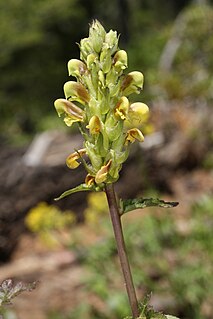
Pedicularis is a genus of perennial green root parasite plants currently placed in the family Orobanchaceae.

Apocynum androsaemifolium, the fly-trap dogbane or spreading dogbane, is a flowering plant in the Gentianales order.

Pedicularis furbishiae, or Furbish's lousewort, is a perennial herb found only on the shores of the upper Saint John River in Maine and New Brunswick. Furbish's lousewort was first recognized as a new species by Maine naturalist and botanical artist Kate Furbish in 1880. It is considered an endangered species in the United States and Canada, and is threatened by habitat destruction, as well as riverside development, forestry, littering and recreational use of the riverbank. It was formerly in the family Scrophulariaceae, but is now placed in the family Orobanchaceae.

Pedicularis groenlandica is a showy flowering plant in the family Orobanchaceae which is known by the common names elephant's head and elephanthead lousewort. This erect plant can grow to a height of 80 centimetres (31 in). Its sharply-toothed fernlike leaves are located low on the stout stem. The stem is topped with a large inflorescence of bright pink to purple or white flowers. Each flower has a long, pointed beak which curves upward, superficially resembling the trunk of an elephant, and the lateral lobes of the flower resemble an elephant's ears. Like other louseworts and related broomrape genera, this is a root parasite which obtains nutrients from the roots of other plants by piercing them with haustoria. This plant is found in the high mountain ranges of western North America, particularly the Cascades and High Sierra, much of Canada and Greenland. It grows in wet environments such as riverbanks.

Hieracium albertinum, known as western hawkweed or houndstongue hawkweed, is a species of the genus Hieracium that is very similar to Hieracium albiflorum with white flowers but differs in that the flower heads are clustered and the leaves, stems and bracts are covered in a thick layer of hairs. Standing 1 inch (3 cm) to 5 inches (13 cm) tall, it can be found blooming from June through August in forest clearings.

Pedicularis centranthera is a species of flowering plant in the family Orobanchaceae known by the common names dwarf lousewort and Great Basin lousewort. It is native to the western United States from eastern Oregon and California to Colorado and New Mexico, where it grows in sagebrush and other basin and plateau habitat. It is a perennial herb producing several short stems a few centimeters tall from a basal caudex. The leaves are up to 20 centimeters long, lance-shaped and divided into many overlapping toothed, wrinkled, or fringed lobes. The inflorescence is a short raceme bearing many long, protruding, club-shaped flowers. Each flower may exceed 4 centimeters in length and is white or pale purple with dark purple tips on the wide ends of its upper and lower lips. The sepals of the flowers are shorter and hairy. The fruit is a capsule around centimeter long containing seeds with netlike surfaces.

Pedicularis contorta is a species of flowering plant in the family Orobanchaceae known by the common names coiled lousewort and curved-beak lousewort. It is native to western North America, including southwestern Canada and the northwestern United States, where it grows in moist mountainous habitat, such as bogs, shady forests, and meadows. It is a perennial herb producing one or more stems up to 40 centimetres (16 in) tall from a caudex. The leaves are up to 18 centimetres (7.1 in) long, lance-shaped to oblong, and divided into many linear lobes which may be toothed or smooth-edged. The inflorescence is a raceme of flowers occupying the top of the stem. Each flower is a centimeter long or slightly longer, white to yellowish in color, and divided into a coiled or curved beak-like upper lip and a flat, three-lobed lower lip. The fruit is a capsule up to a centimeter long containing seeds with netted surfaces.
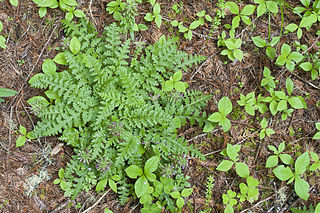
Pedicularis dudleyi is a rare species of flowering plant in the family Orobanchaceae known by the common name Dudley's lousewort. It is endemic to central California, where it is known from about ten scattered occurrences along the coast and in the coastal mountain ranges. It has been found in three locations along the Central California coast. The species was named for 19th-century Stanford University botanist William Dudley.
Pedicularis howellii is an uncommon species of flowering plant in the family Orobanchaceae known by the common name Howell's lousewort. It is endemic to the Siskiyou Mountains of the Klamath Range in southern Oregon and northern California, where it grows on the edges of coniferous forests. This is a perennial herb producing one or more stems up to 45 centimetres (18 in) tall from a long caudex. The leaves are up to 20 centimetres (8 in) long, lance-shaped, and divided into many toothed oval lobes; those higher on the stem may be unlobed. The basal leaves fall away early. The inflorescence is a small raceme of flowers occupying the top of the stem. Each white to light purple flower is up to one centimetre long and is sickle-shaped, with a curved beak-like upper lip and a three-lobed lower lip which may be tucked into the hairy mass of sepals. The plant is pollinated by bumblebees including Bombus mixtus. Between the flowers are hairy to woolly triangular bracts. The fruit is a capsule just under a centimeter long containing seeds with netted surfaces.
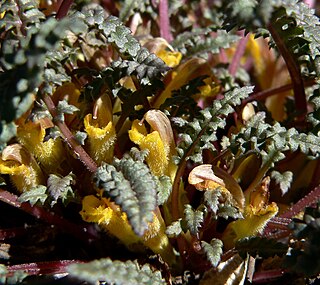
Pedicularis semibarbata, known by the common name pinewoods lousewort, is a species of flowering plant in the family Orobanchaceae.
Castilleja kerryana is a species of flowering plant in the family Orobanchaceae. It is commonly known as Kerry's Indian paintbrush or Kerry’spaintbrush. It was formally described in 2013 and so far it is known only from a small population in the state of Montana, in the Northwestern United States.

Pedicularis verticillata, the whorled lousewort, is a species of flowering plant in the family Orobanchaceae which can be found in Alaska, North-Western Canada, and everywhere in China at the elevation of 2,100–4,400 metres (6,900–14,400 ft). Its native habitats include moist meadows and lakeshores.

Grevillea bracteosa, also known as bracted grevillea, is a species of flowering plant in the family Proteaceae and is endemic to the south-west of Western Australia. It is an erect to spreading shrub usually with linear leaves, and oval to more or less spherical clusters of glabrous pale green to greenish-pink flowers with a pink or white style.
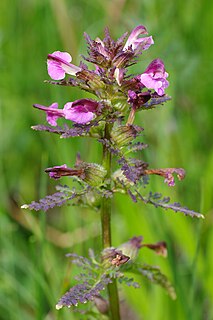
Pedicularis palustris, commonly known as marsh lousewort or red rattle, is a plant species in the family Orobanchaceae. It is native to central and northern Europe and Asia where it grows in wetlands and boggy habitats. The International Union for Conservation of Nature has assessed its conservation status as being of least concern.
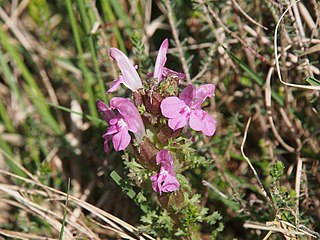
Pedicularis sylvatica, commonly known as common lousewort, is a plant species in the genus Pedicularis. It is native to central and northern Europe where it grows on moist acidic soils, moorland, grassy heathland and the drier parts of marshes.

Chionophila tweedyi, or Tweedy's snowlover, is a perennial herb in the plantain family. It is native to Idaho and Montana in the western United States.





















